Original authors: Elliot Hershberg and Jocelynn Pearl
Translation: LlamaC
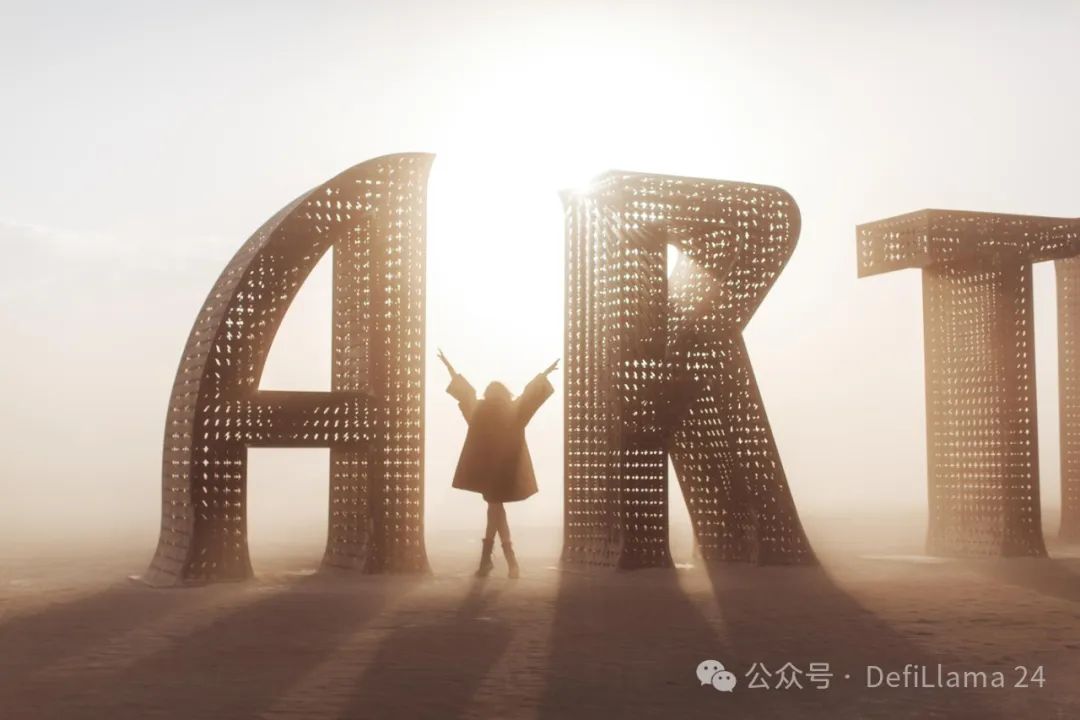 (Portfolio: Burning Man 2016, about Tomo: illustration by the Ethereum Foundation)
(Portfolio: Burning Man 2016, about Tomo: illustration by the Ethereum Foundation)
"Recommended message: This article helps you understand why Binance invested in BIO Protocol, discussing the changes in funding for scientific research, the structure of existing scientific research institutions, and how Web3 technology and the current DeSci narrative are changing the funding and organization of scientific research."
Main Text
Science is the fundamental tool driving human progress.
It is a system we construct to derive detailed explanations of objective realities that are difficult to change. These types of explanations require coherent models that can account for empirical observations. The only way to arrive at these types of explanations is through challenging experimental and theoretical work to ensure that all details of the explanation function effectively and are closely connected to objective reality. This nature of explanation is at the core of our transition from myth to physics, from caves to skyscrapers. Physicist David Deutsch believes this is the central idea of the scientific revolution: "Since then, our understanding of the physical world and how to adapt it to our desires has been continuously growing."
The guiding light of scientific discovery is one of our most valuable resources and must be managed with care. In addition to developing new explanations, we have built a complex human system to transform new knowledge into inventions that drive the modern world. Researching and improving this system is crucial—it requires interaction with countless complex human systems. As the visionary Vannevar Bush articulated, "We need legislators, courts, and the public to have a better understanding of the entire complex affair. Invention will not be lacking; true inventors are those who cannot help but invent. But if we want more successful inventions, we need better understanding to achieve them."
Guided by the mission to accelerate scientific progress, Vannevar Bush led efforts to expand the U.S. research funding system to its current scale. This powerful system is what scientist and former director of the Office of Science and Technology Policy Eric Lander calls the "miracle machine."
 Miracle machine; created using Midjourney
Miracle machine; created using Midjourney
Our systematic efforts in funding basic science have ultimately led to miracles such as the internet, artificial intelligence, cancer immunotherapy, and CRISPR gene editing technology. While the results so far have been miraculous, this machine does not run on its own: maintaining this system is absolutely essential.
However, over time, we have become complacent in maintaining this machine.
Lander coined this term while passionately advocating for an increase in federal research budgets, while in reality, research budgets have been decreasing in recent years. Over time, "adjusted for inflation, the budget of the National Institutes of Health (NIH) has declined by nearly 25% since 2003." The challenges of funding science are not just about advocating for larger budgets. Our actual funding mechanisms have become increasingly rigid, inefficient, and consensus-driven. A U.S. government study estimates that professors now "spend about 40% of their research time navigating bureaucratic mazes," which is necessary for funding their laboratories. In another alarming survey, 78% of researchers indicated that if they received unrestricted funding, they would "significantly" change their research plans. Young scientists also face a severe bottleneck in obtaining funding early in their careers, despite this being potentially the most productive and breakthrough period of their lives.
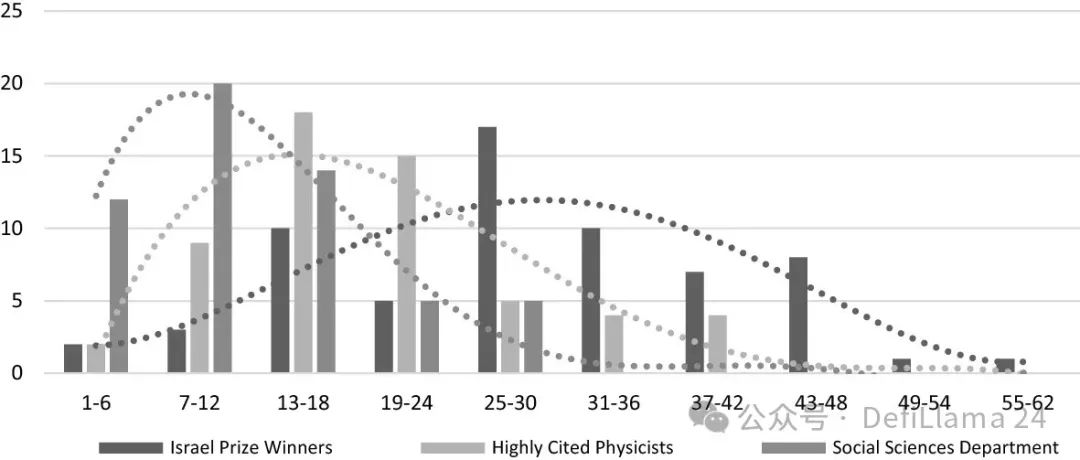 Yair & Goldstein, 2019. Figure 2 Distribution of miracle years (or peak publication years) in career age across three small studies
Yair & Goldstein, 2019. Figure 2 Distribution of miracle years (or peak publication years) in career age across three small studies
In addition to laboratory funding, there are serious structural bottlenecks in the process of translating scientific discoveries into new drugs and products. This is what former NIH director Elias Zerhouni referred to as the "valley of death." In recent years, the pace of company creation in the biotechnology sector has slowed. Physician and scientist Eric Topol recently pointed out that despite our profound progress in understanding the human genome, this knowledge has not yet been practically applied in clinical settings.
Any optimist and advocate for human progress should view the health and efficiency of our "miracle machine" as of core importance, and we are clearly far from realizing our full potential.
So, what should we do?
Challenges and inefficiencies represent new opportunities. In recent years, innovations in research funding mechanisms have exploded. Meta-science—the study of science itself—has become an applied discipline. Will the next miracle machine be a modernized version of our current system, or will it be something entirely new? Where and how will the next round of scientific progress occur? These are core questions for almost all types of innovation. As R. Buckminster Fuller said, "You never change things by fighting the existing reality. To change something, build a new model that makes the existing model obsolete."
When analyzing complex human systems with multiple layers of incentives, following the flow of funds is often surprisingly good advice.
All the President's Men | Follow The Money Scene | Warner Bros. Entertainment
https://youtu.be/QodGxD19_as
The goal we explore here is to better understand how we currently fuel the miracle machine. How do we actually fund scientific innovation and commercialization? From there, we will examine ideas, technologies, and projects aimed at changing this process.
Let’s delve into some innovations in research funding in recent years, from private capital to cryptocurrency, to establishing entirely new research-focused institutions targeting the unknowns in our scientific understanding.
We will explore:
- A macro perspective on current scientific funding
- Killer Web3 application scenarios
- Faster gas, faster funding
- Comprehensive adoption of Bucky (building from scratch)
A Macro Perspective on Current Scientific Funding
How is the current miracle machine actually constructed?
Almost all scientific disciplines can be roughly divided into three types of organizations:
- Academic institutions (universities, nonprofit research institutes, etc.)
- Startups
- Corporations (mature enterprises with R&D laboratories)
Let’s specify this by observing how biomedicine operates. The National Institutes of Health (NIH) has an annual budget of about $45 billion, making it the primary source of funding for biomedical research. Other agencies, such as the National Science Foundation, with an annual budget of about $8 billion, are also important funding bodies. These large government agencies allocate funds to principal investigators (PIs) applying for funding through various grant mechanisms. PIs are typically professors at research universities or medical schools responsible for managing laboratories. Actual research work is carried out by graduate students, temporary postdoctoral researchers, and some professionals, while the PI serves in a managerial role.

This layered funding and organizational structure is not the only way we conduct laboratory scientific research. Outstanding chemist and microbiologist Louis Pasteur (after whom pasteurization is named) personally conducted many experiments with the help of laboratory assistants (as mentioned above). This was actually a key part of his research process: he trained himself to maintain a "prepared mind" to notice even subtle results in experiments. Today, "be careful when the principal investigator enters the lab" has become a common joke, as their experimental skills have become rusty.
Emily Noël broke laboratory equipment during an operation due to excessive force.
https://x.com/noelresearchlab/status/1171376608437047296
It is difficult to pinpoint when the shift to the modern laboratory system occurred, but World War II was a critical turning point. Given the importance of the Manhattan Project in the war effort, scientific funding underwent a significant transformation: it was no longer just about supporting the pursuit of knowledge—scientific funding had a direct impact on national security and economic growth. These ideas were best articulated in Vannevar Bush's 1945 report "Science—The Endless Frontier."
In the years that followed, many of the scientific and biomedical research institutions we have today emerged. Since World War II, the number of medical schools in the U.S. has doubled. Between 1945 and 1965, faculty positions increased by 400%. Science was no longer a solitary intellectual pursuit but increasingly became a team endeavor funded by government grants. This is often referred to as the increasing "bureaucratization" of science.
Thus, the first major gear of the miracle machine is government-funded research laboratories.
Laboratories are responsible for constructing foundational explanations of the world, making them possible. The commercialization of science is achieved through the establishment of spin-off companies centered around specific intellectual property (IP) with translational potential. These spin-off companies are funded by venture capital (VC), which is primarily financed by limited partners (LPs). Limited partners are institutions such as university endowments, pension funds, and family offices.
This is the second gear of the miracle machine: startups and university spin-offs supported by private capital.
Biotech startups primarily focus on scaling and expanding the initial science they are based on and go through a daunting and lengthy process to obtain approval for new drugs. This process does not end with approval. Drugs must be produced, marketed, and sold globally. This phase of work is carried out by pharmaceutical companies, many of which are large multinational corporations that have existed for over a century, in some cases even predating the establishment of the Food and Drug Administration (FDA) responsible for drug approval. Pharmaceutical companies primarily do not develop drugs themselves but purchase assets from biotech companies, which often involves acquiring entire companies.
Large-scale R&D enterprises like major pharmaceutical companies are the third major gear of our current miracle machine.

This machine has indeed created miracles.
The story of Ginkgo Bioworks is just one example. Pioneering academic work at Stanford University was spun off into a venture capital-backed company. This company successfully transformed bacterial cells into miniature insulin production factories through genetic engineering—significantly alleviating a shortage of an important medication. In 2009, Ginkgo Bioworks merged with Swiss pharmaceutical giant Roche in a $47 billion deal, promising to scale globally.
But the story doesn’t end there. Breakthrough technologies like cell therapy and CRISPR gene editing are still transitioning from academic laboratories to clinical applications. Academic labs continue to develop new theories and models, while companies are forming and securing funding based on the most promising advancements. The pharmaceutical industry remains the primary global buyer and distributor. This system has reached a certain stable balance among its various participants.
Despite the miracle machine improving our world, systemic challenges have emerged over time. We provide this bird's-eye view of the current system to make it easier for people to understand some of the issues within it and to provide context for understanding new projects that seek to address these problems.
Large funding agencies like the National Institutes of Health (NIH) have become increasingly bureaucratic over time, inherently biased towards funding more conservative and incremental work. We are quite certain that no one really believes scientists should spend up to 40% of their time struggling with cumbersome government paperwork. As the funding process becomes more complex and committee-driven, new and promising research directions are increasingly difficult to support.
The NIH has also shown interest in "big science" projects, which organize large research teams to fund projects that individual labs cannot complete. While this seems important in principle, the outcomes of such projects are mixed and consume resources that could otherwise be used to fund labs focused on basic discovery science. As Berkeley biologist Michael Eisen puts it, "Big biology projects are not the salvation of personally driven discovery science. Ironically and tragically, they are becoming the greatest threat to the latter's continued existence."
The large-scale structural changes in government research funding have shaped and limited the types of scientific questions researchers can pursue. The relay between universities and startups has also become more complex. In the translational phase, the terms for university spin-offs have proven to vary widely, sometimes even putting them in a difficult position before the company gets off the ground. Universities are strongly incentivized to tightly protect their intellectual property, which can lead to worse terms for scientists and may even result in terms so unfavorable that they dissuade investors from funding translational efforts.
Government agencies are not the only part of the system with funding blind spots. Venture capitalists also have inherent limitations on the projects they can invest in—companies must have the potential to become massive exit projects worth over a billion dollars for the math to make them feel worthwhile to invest in. Not all technologies or public goods can generate such returns, especially within the time constraints imposed on investors. Only a small fraction of society has the opportunity to gain real wealth by supporting these private investments, further exacerbating inequality.
Pharmaceutical companies are similarly constrained by their financial structures and incentive mechanisms. The clear incentive is to develop or acquire the biggest drugs on the market while minimizing R&D costs. This distorts the entire pipeline in a suboptimal way, leading to real consequences: "Despite significant unmet needs and disease burdens, there are almost no products in the pipeline to address antimicrobial resistance, tuberculosis, and opioid dependence. In contrast, many new products are merely new versions of existing products, making only minor changes to existing drugs."
So where should we look for new ideas and approaches?
It is unlikely to receive radical solutions from the leaders of our current institutions, as they have incentives to perpetuate the systems they are in. An interesting direction for seeking new ideas is to explore the side projects that innovative scientists are undertaking. As Paul Graham has said about great startup ideas, "The best ideas almost have to come from side projects, because they are always so different that your mind will reject them as company ideas."
In adopting this approach, it is hard to ignore the steady expansion of activities within the decentralized science community.
Killer Web3 Use Cases
Personally, I was initially highly skeptical of web3. As a scientist and engineer, one of my core areas of focus has been leveraging the powerful capabilities of web2 technologies—efficient centralized databases, fast servers, and powerful modern browsers—to build cutting-edge research tools for scientists. Measurements and technical assessments like Moxie Marlinspike's initial impressions of web3 have been the foundation of my thinking in this area.
But over time, I have become a cautious optimist—ironically, this has happened just as the cryptocurrency market collapsed and skepticism towards web3 increased. Why? When I talk to smart people like Packy, Jocelynn, and some leading founders in the field, I feel excited about the areas where this new set of protocols, tools, and ideas might excel. We are observing some significant social experiments attempting to establish new modes of collaboration and organization. From my direct experience in academic science, I know our research institutions could benefit from changing the status quo.
Readers of "Not Boring" may be familiar with the huge Web3 use case debate that our fearless leader Packy has recently been involved in. One tangible advantage of Web3 is that it provides a new set of tools for creating financial instruments. As Michael Nielsen points out, "New financial instruments can, in turn, be used to create new markets and enable new forms of collective human behavior."
What if one of the killer applications of this new tool stack is to radically improve the research funding process?
As we have emphasized so far, research funding has traditionally been roughly divided into two categories: public or private financing. Once cryptocurrency investors began to generate massive wealth, a third source of funding emerged, and many of these new investors want to use their funds for good.
This point alone is worth a moment of simple reflection. The expansion of cryptocurrency has created a new breed of billionaires, primarily those willing to be early adopters of an entirely new financial system. As Tyler Cowen has discussed, this could change philanthropy, as these new technological elites may have a greater interest in "quirky independent projects." We have already seen this dynamic in action, with Vitalik Buterin and Brian Armstrong making significant investments in longevity science projects.
This difference is not limited to the emergence of a group of younger, more tech-savvy investors and philanthropists. Web3 technologies are being used to enhance funding support for novel and quirky scientific projects. Today, new financing mechanisms, including token sales and cryptocurrency-backed crowdfunding, are introducing a whole new way to fund projects.
Crowdfunding has traditionally been a challenge for scientific research, but cryptocurrency crowdfunding may be changing that. A series of new open protocols and tools have emerged aimed at scaling funding for public goods. One example is Gitcoin, an organization dedicated to building and funding public goods. Every quarter, they conduct a round of crowdfunding supported by major donors like Vitalik Buterin. The interesting innovation here is that grants use quadratic matching—meaning the number of donors has a greater impact on the matching than the amount donated. In the latest GR15 grant round, decentralized science (DeSci) was listed as one of four impact categories, highlighting the growing interest in scientific research within the Web3 space.
Gitcoin GR15 grant round
https://x.com/umarkhaneth/status/1575147449752207360
The DeSci round received donations from 2,309 unique contributors, supporting 83 projects and raising $567,983. A group of interesting large donors provided funding for matching contributions; among them were Vitalik Buterin (co-founder of Ethereum), Stefan George (co-founder and CTO of Gnosis), Protocol Labs, and… Springer Nature Group.
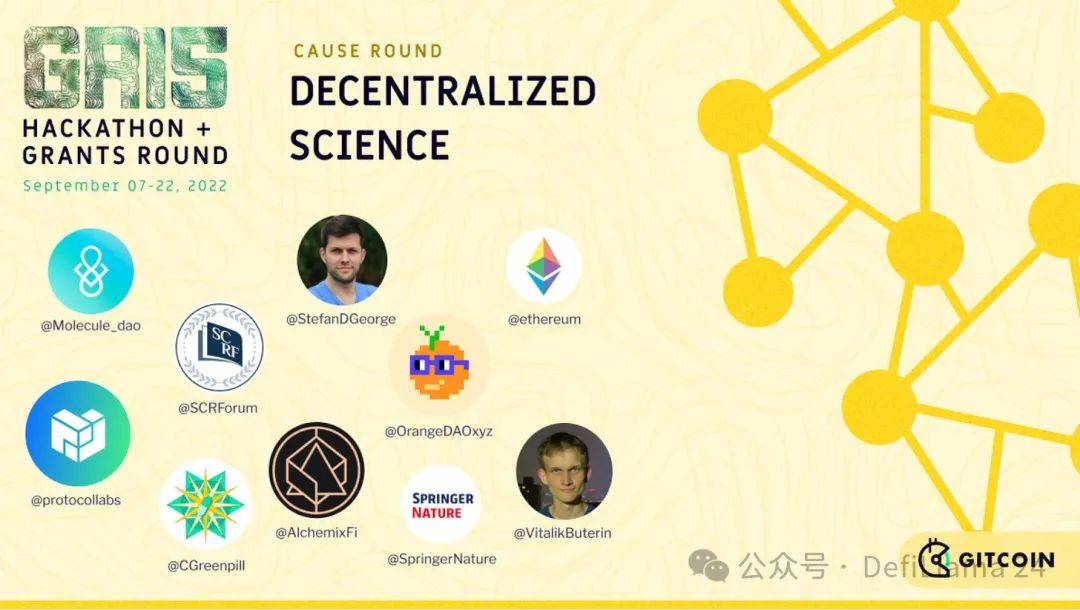
The scientific community is also drawing on another blockchain technology innovation: decentralized autonomous organizations (DAOs).
As Packy previously described, DAOs are an innovation in Web3 governance. DAOs "run on the blockchain, giving decision-making power to stakeholders rather than executives or board members." They are "autonomous" because they rely on software protocols recorded on a publicly accessible blockchain, "which trigger actions if certain conditions are met, without human intervention."
Like Gitcoin and quadratic funding, one of the most exciting early use cases for DAOs is to accelerate the building and funding of the scientific community. Over the past year, scientific DAOs have experienced a Cambrian explosion. Here is an overview of some DAOs and projects in the field:
 UltraRare Bio compiled and updated this snapshot of the DeSci field on October 13, 2022.
UltraRare Bio compiled and updated this snapshot of the DeSci field on October 13, 2022.
If we view traditional science as a "top-down approach" occurring within established and highly centralized university centers, then scientific DAOs showcase a rising trend of "bottom-up" scientific development. Many of the communities displayed in this field are formed when a group of people adopts a common goal—such as advancing research in agriculture or hair loss. These are not just Reddit-like discussion forums; most DAOs include dedicated working groups that often mix experts with amateur scientists, working on tasks such as conducting new literature reviews for their areas of interest or evaluating projects for funding.
One of the initial promises of DeSci is the democratization of funding acquisition; essentially, research that would have previously been unfunded is now receiving support. But is this true in community-funded projects like the transaction process group of VitaDAO? Among the funded projects listed on their website, several university researchers received grants of about $200,000 to $300,000.
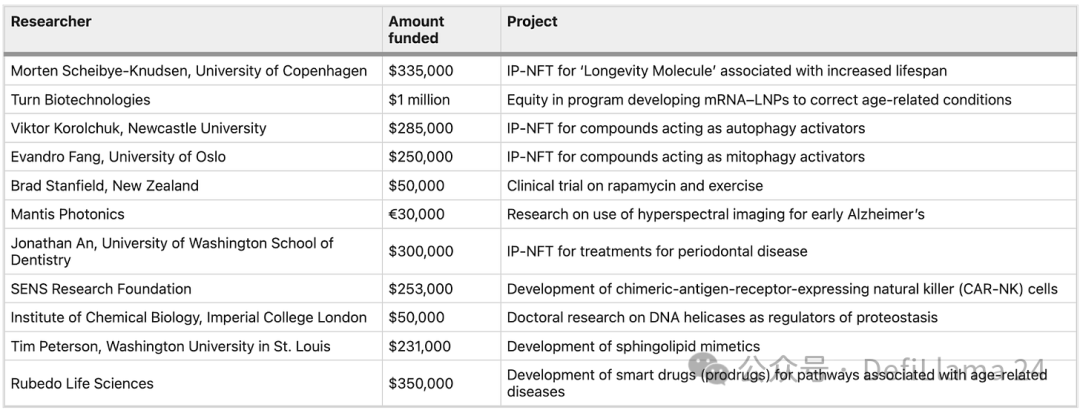
How do researchers funded by VitaDAO differ from those receiving traditional NIH funding? Take Dr. Evandro Fang as an example; his project on novel mitochondrial autophagy activators recently received a $300,000 investment from VitaDAO. According to his resume, his work has received multiple NIH and other government grants. Another argument for the novelty of the VitaDAO approach is that their community reviews and funds these projects faster compared to the NIH, even though there is a high overlap among the funded recipients.
So far, crowdfunding projects like Gitcoin and organizations like VitaDAO within the DeSci community have set their sights on accelerating and simplifying the funding process for basic research. Other projects have begun to address the shortcomings of the biopharmaceutical industry that we have emphasized, such as drug development for rare diseases.
Another early selling point of the DeSci field is its potential to advance treatments for underserved patient populations, such as those with ultra-rare diseases. Traditional biotech companies often do not develop drugs for smaller patient populations because they cannot justify the high costs of clinical R&D with sufficient profits from the final product. However, decentralized global teams are advancing the identification of repurposed drugs for rare disease patients. Examples include Perlara and Phage Directory, which do not rely on blockchain technology but indeed support the argument that knowledge from decentralized networks can advance the development of treatments.
In terms of organizations on the blockchain, Vibe Bio is a new company embracing web3 as a way to find "every treatment for every community." Vibe founders Alok Tayi and Joshua Forman plan to establish a web3 protocol for creating patient community DAOs that can collectively own and manage their drug development. This is an exciting innovation in a field where patient communities have been self-organizing for decades, but often with companies owning the data and assets. This poses risks for patient foundations that frequently provide seed funding for science. These companies can choose to shelve these projects, as seen with Taysha Gene Therapies' recent Leigh syndrome project.
Vibe recently raised $12 million from traditional venture capital firms, including Not Boring Capital; this is a positive signal that connecting patient communities through DAOs may become a favorable process for developing treatments for rare diseases. Founder Alok Tayi was inspired to create Vibe after his daughter was born with an incurable disease. In an interview with the Not Boring podcast, when asked "Why choose web3?" Tayi responded:
Our goal is to create an infrastructure approach through which we can potentially address all neglected and overlooked diseases. Therefore, the first thing we need to consider is the technological and governance solutions that allow us to achieve unlimited scalability of participation, while also requiring a whole new source of capital that is interested in taking bold actions and accomplishing significant matters.
The constraints of biotech venture capital drive them to make slightly more conservative investments rather than a broader range of diseases. Another aspect I want to emphasize here is that when you look at the approaches others might take, whether they are charities, academic institutions, or even C-corporations or LLCs, there are inherent limitations in terms of the amount of funding, the types of expertise, and the number of owners and participants who can actually engage in this process. Therefore, our ambition at Vibe, our mission is to find every treatment for every community, not just those 250 recognized investors or qualified buyers who are allowed to participate in these traditional types of institutions.
In addition to cryptocurrency funding and DAOs, many novel ideas are exploring how to apply token economics to science and improve some of its shortcomings. Among these strategies is IP-NFT; essentially, intellectual property tied to non-fungible tokens. A company called Molecule has implemented this proof of concept for biopharmaceutical assets for the first time. They aim to create an "open market for drug development."
The integration of web3 with science is still in a very early stage; time will tell how these new experiments in scientific funding, ownership, and organization will evolve. We are cautiously optimistic that even if blockchain is not the answer to the scientific ecosystem crisis, it has at least reignited discussions about what needs fixing and started to allocate this new form of liquidity to one of the best use cases.
Faster Gas, Quick Funding
Experiments in decentralized science demonstrate that the web3 community has a tremendous enthusiasm for funding scientific research and commercial translation. This should not be underestimated. While the NIH has an annual budget of $50 billion, it still requires constant deep political maneuvering to persuade American taxpayers to increase the scale and scope of scientific spending. Given this significant difference in enthusiasm, it is entirely conceivable that a $1 trillion expenditure in the cryptocurrency market could surpass the U.S. government's spending on scientific funding.
Beyond cryptocurrency, tech philanthropists are also targeting some of the major inefficiencies in our modern scientific funding system. A prominent example is the deployment of emergency funds during the pandemic. Even in the face of a global emergency, the NIH demonstrated an inability to deviate from its rigid funding structure:
The cumbersome process scientists had to follow to obtain emergency NIH funding during the pandemic
https://x.com/patrickc/status/1399795033084096512
To deploy funds more quickly, the Fast Grants project was born. Initiated by Emergent Ventures and supported by a range of well-known tech leaders, including Elon Musk, Paul Graham, and the Collison brothers, the project aims to significantly shorten the time required to launch important COVID-19-related research projects. Their argument is simple: "During normal times, the scientific funding mechanism is too slow, and it may be even slower during the COVID-19 pandemic. Fast Grants is an effort to correct that."
Here is an important lesson that requires us to revisit our mental model of how the NIH was originally established. As we currently see, our funding system is primarily designed by the visionary Vannevar Bush, who was a key member of the National Defense Research Committee (NDRC) that achieved rapid results during World War II. Part of the mission of the Fast Grants program is to return to the kind of efficient system that Bush himself advocated. In his memoirs, Bush recalled: "Within a week, the NDRC could review projects. The next day, the director could authorize, and the business office could issue a letter of intent, and actual work could begin."
The program was initially designed to accelerate research and understanding of COVID-19 during a global pandemic, but this model seems to have appeal beyond this use case. In an article for Future, Tyler Cowen, Patrick Hsu, and Patrick Collison reflect on some of the project's outcomes:
We originally expected to receive at most a few hundred applications. However, within a week, we received 4,000 serious applications, with almost no spam. Within days, we began distributing millions of dollars in grants, and during 2020, we raised over $50 million and issued more than 260 grants. All of this was accomplished with Mercatus managing fees of less than 3%, partly due to the infrastructure built for Emergent Ventures, which was also designed to issue (non-biomedical) grants quickly and efficiently.
Incredibly, approved grants received funding within 48 hours. A second round of funding would follow within two weeks. Funded recipients were required to publicly publish their results and share a brief update each month.
Among some interesting findings, many applicants came from top universities, a group that the organizers originally thought was already well-supported by traditional NIH-style funding. Meanwhile, 64% of funded recipients indicated that this research would not have occurred without Fast Grants. Again quoting Collison, Cowen, and Hsu:
Fast Grants pursue low-hanging fruit, choosing the most obvious bets. Its unusual aspect is not in coming up with clever funding targets but in finding a mechanism for actual execution. For us, this indicates a possible lack of clever managers in mainstream institutions who can be trusted to manage flexible budgets and allocate funds quickly without triggering a lot of red tape or committee-driven consensus.
Fast Grants is a method being adopted by multiple organizations. This includes the Longevity Research Impetus Grants, founded and led by 22-year-old Thiel Fellow Lada Nuzhna. The first round funded 98 projects aimed at accelerating research on aging biomarkers, understanding aging mechanisms, and improving the translation of research to clinical settings. While one explicit goal of the project is to fund research that traditional sources might overlook, the list of funded recipients includes several well-known longevity researchers, and its acceptance rate is actually stricter than that of the NIH (Impetus Grants has a 15% acceptance rate, while NIH is about 20%). Notably, an important aspect of such experiments is that they may push the NIH to adopt and expand some of the most promising new strategies. The Rapid Acceleration of Diagnostics (RADx) program was launched by the NIH around the same time as Fast Grants.
In the coming years, it will be interesting to compare how funding changes the composition of those who can conduct research and the types of outcomes these researchers bring. These different projects highlight two interesting trends.
First, beyond the cryptocurrency market, a new generation of tech philanthropists has shown a sincere interest in funding science in new ways.
Second, sometimes less is more.
As we explore new forms of funding sources, it is worth recognizing that writing grant applications should be secondary, while actually conducting scientific research should be primary. Sometimes, the best solution is to quickly assess and fund the most promising proposals and then not hinder progress.
Fully Embracing Bucky (Building from Scratch)
So far, we have roughly outlined how current institutions operate and seen how the cryptocurrency market, web3 technologies, and tech philanthropists contribute to the landscape of research funding. We now live in a world where Vitalik Buterin provides quadratic crowdfunding support for scientific projects, and the Collison brothers support low-overhead grant mechanisms to alleviate government inefficiencies. These new ideas are being explored to accelerate and expand the miracle machine in exciting and significant ways.
As all these new efforts emerge, an interesting question arises: What if some of the issues in scientific funding cannot be resolved merely through new sources of funding or grant mechanisms?
Ultimately, our current scientific institutions represent only a small sample of the entire possible organizational structure space. The miracle machine we have is a byproduct of a series of very specific historical pressures and ideas. Some of the new funding concepts being explored today require the construction of an entirely new set of 21st-century scientific institutions. In other words, they are practicing Buckminster Fuller's philosophy of exploring new ways to fund and organize science from scratch.
How do new real-life (IRL) research institutes build to address the missing links in science?
One approach is Focused Research Organizations (FROs), a new type of institution dedicated to solving specific scientific challenges, such as blue-sky neurotechnology or longevity research. Other proposed focus areas for FROs include identifying antibodies for every protein, mathematical artificial intelligence, and developing super-durable organ transplants. The core idea of the FRO model is that these types of scientific projects fall into a institutional gap. They are too capital-intensive and team-oriented for academia, yet do not fit within the realm of startups or large corporations, as they resemble public goods rather than products with clear commercial value. FROs aim to fill this gap:
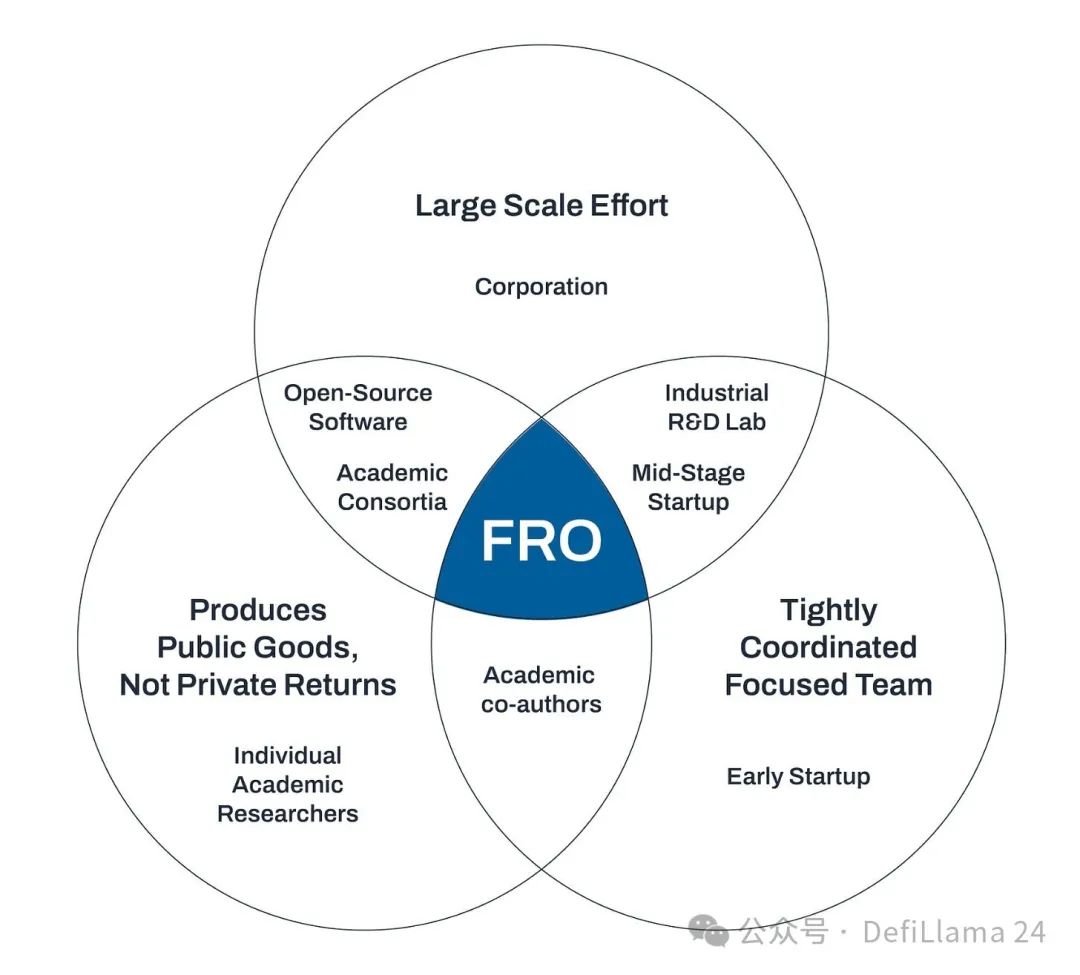
Convergent Research, co-founded by Adam Marblestone and Anastasia Gamick, aims to incubate new FROs. This spring, CR hosted a meta-science workshop that brought together institute heads, policymakers from Washington D.C. and the UK, as well as thought leaders such as writers and changemakers in the meta-science field. The main goal of the workshop was to brainstorm how new organizations can facilitate scientific progress.
A common theme among the speakers was that the scientific ecosystem is broken. To summarize this working hypothesis: the dominant research model based in universities and published in traditional scientific journals is creating a fragile ecosystem that needs to be disrupted.
In a talk by Ilan Gur (then CEO of Activate.org, now CEO of Aria Research), we saw a pie chart showing the distribution of research funding over time.
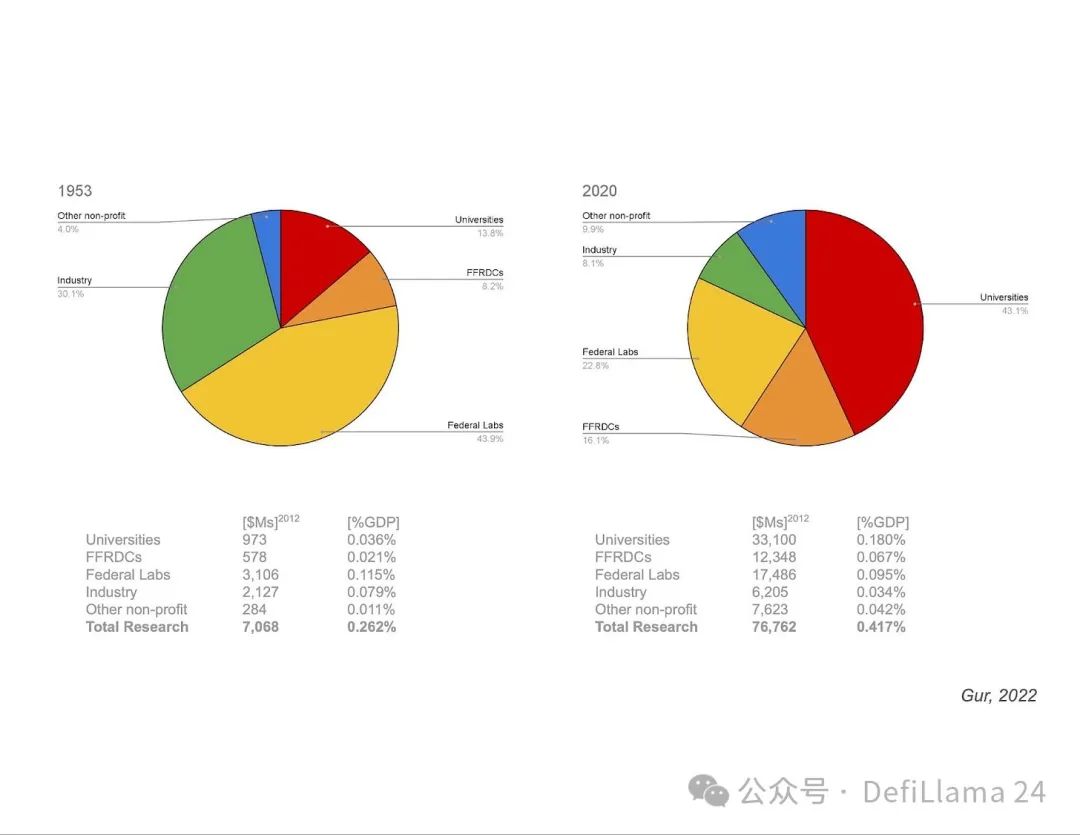
This chart reveals some very interesting insights. The massive restructuring of research funding post-World War II coincides precisely with a significant shift in the composition of our research institutions. U.S. basic research funding transitioned from primarily funding federal laboratories (1953, left pie chart) to primarily funding university research (2020, right pie chart). Should this shift towards a university-centered funding model be held accountable for some of the flaws in our current ecosystem?
In another talk, we watched a video clip of scientists discussing setting magic at the Santa Fe Institute:
A preview of the upcoming documentary about the Santa Fe Institute
https://www.youtube.com/watch?v=xc6IHZosKY8
"What we do at the Santa Fe Institute is escape society; we build a community in the mountains under the shadow of the atomic bomb." — David Krakauer, President of the Santa Fe Institute.
The intimacy and beauty of this environment are intoxicating. The Santa Fe Institute represents a genuine departure from the traditional research university institutional structure—thus it has its own unique culture. It provides a space for rebellious scientists to pursue their boldest and most unique ideas. While watching the video, we wondered: How can we create more places like this? What does it take to design a space that can nurture the next Feynman or Einstein of the world? How large should the teams be? What about leadership?
Many meta-science changemakers or rebellious scientists are following Buckminster Fuller’s principles to establish new institutions in the real world.
Among leading research institutions, Arcadia Science, led by Seemay Chou and Prachee Avasti, stands out. Arcadia is an experiment in applying meta-science. The structure of the institute resembles a research and development company but primarily focuses on basic science and technology development. One of its core ideas is that we fundamentally misunderstand the value of basic science, especially if institutional design can help scientists effectively translate their work into new products and technologies.
In this process, Arcadia is experimenting with every part of its research process. For example, they break the status quo of the scientific publishing ecosystem by prohibiting scientists from publishing articles in traditional journals; instead, they publish journal-like articles on their own website, including project descriptions, data, comments, and even links to tweets. While this may seem trivial, it is a conscious departure from the strange dynamics and exploitative nature of the existing academic publishing system. The self-publishing experiment may improve the ways in which code, data, and results are shared with other scientists who wish to continue research based on this foundation.
Another interesting institutional building application experiment is New Science. The organization is primarily the brainchild of writer and researcher Alexey Guzey, who spent a year writing a classic blog post titled "How Life Sciences Actually Work," exploring the realities of current biomedical institutions. One major observation that left a deep impression on Alexey was the lack of funding opportunities for young scientists:
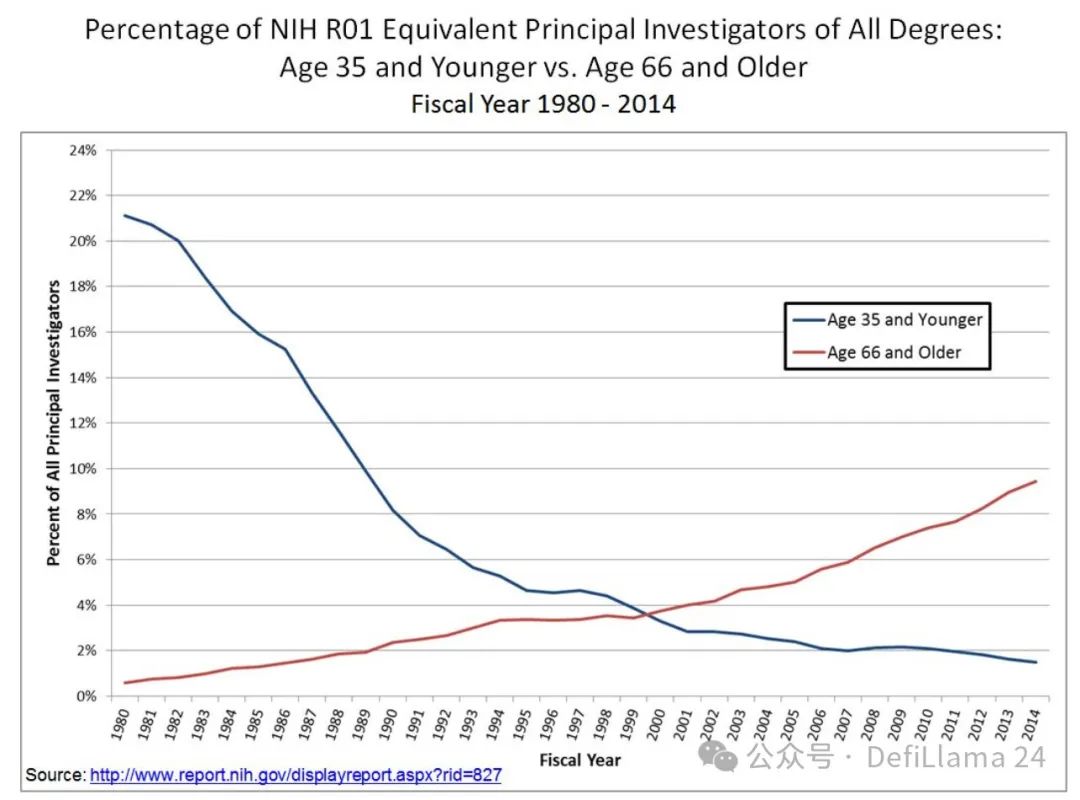
Over time, an increasing proportion of research funding has been used to support older (literally) scientists, making it more difficult for young scientists to secure initial funding for their labs. This chart does not even reflect the full picture: it only reflects the difficulties young professors face in obtaining funding. Young scientists pursuing their PhDs or engaged in postdoctoral research have even less autonomy—they primarily work on projects that professors can secure funding for. While technology has greatly expanded the agency of young people—providing them with pathways to start, finance, and lead their own companies—young scholars often cannot truly develop or secure funding for their own projects.
One of the core goals of New Science is to fill this gap. They have launched a short-term fellowship program allowing young scientists to pursue their own ideas and projects. Over time, the plan is to create more long-term fellowship programs and ultimately establish independent research institutes that allow young scientists to regain control over their work:
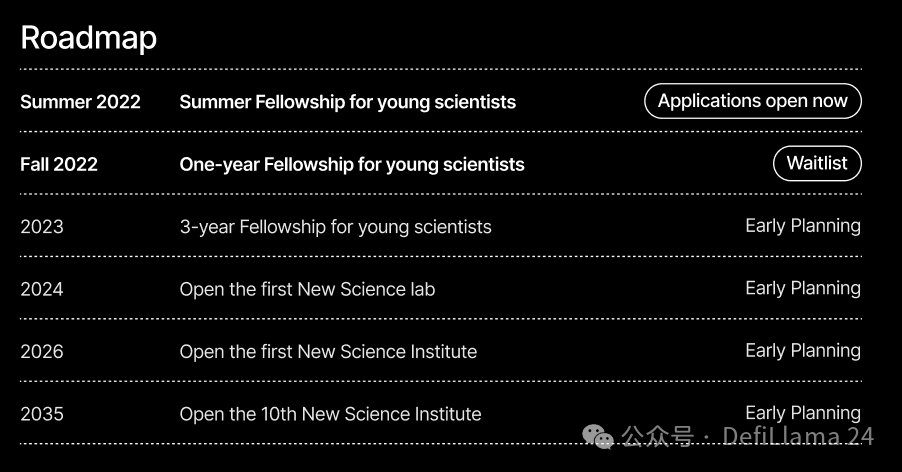
Similar to Arcadia, they will conduct various applied meta-science experiments in the process. For example, they encourage researchers to share articles about their ideas and work on their Substack—you should really consider subscribing. They also fund more research and writing about how our current life sciences institutions actually operate, such as their large report on the NIH or Elliot's article on funding for life sciences software.
So far, one criticism of these new research institutions is that they largely rely on the support of large donors, such as Eric Schmidt. Nadia Asparuhova has documented some of the ways emerging tech elites have pursued philanthropy in the life sciences in recent years, a trend that shows no signs of slowing down. In addition to the Chan-Zuckerberg Biohub, we have also seen the establishment of another tech-supported life sciences center—the Arc Institute. Within the realm of independent research institutions, there is some debate about the best type of funding—can a single donor provide the institute with ultimate intellectual freedom, whereas the wishes and biases of multiple donors might pull the institute in too many directions?
This question highlights a key philosophical difference between decentralized science and many emerging institutions. The decentralized science movement is attempting to build new protocols and tools to empower decentralized networks of scientists and technologists to organize and act more effectively. If there is a significant funding gap, why establish an FRO? Why not directly create a new DAO that allows the scientific community to naturally figure out solutions once they have the resources?
Laura Minquini raised concerns on X about the inequitable distribution of NIH research funding in the fields of women's health and reproductive aging
https://x.com/LauraMinquini/status/1565409539364626433
After decades without substantial innovations in research funding or institutional building, we are now witnessing all these experiments occurring simultaneously. As we have argued, science is one of the most valuable and productive pursuits of humanity, and there should be ample space to accommodate new ideas and resources. Nevertheless, there may be some competition between different approaches. As Nadia pointed out, "I am particularly interested in observing how the tension between tech-native and crypto-native approaches unfolds. While they are at different stages of maturity, from a macro perspective, these are two significant experiments happening simultaneously."
Conclusion
Science is one of the most powerful tools we have as a species to make progress. As Packy argues, it is an inherently optimistic process: "Experimenting to better understand the universe, assuming we can discover more knowledge than we currently know, and using it to improve the world." We are fortunate to live in a world that can be explained, and as our knowledge increases, this world can be changed in new ways.
Due to the central role of scientific research during World War II, American leaders like Vannevar Bush designed a massive government machine to expand scientific funding at the national level. We now live in a world driven by the miracles produced by this machine. Above our vast federal funding system, there are several layers that are ultimately necessary for producing products. Technology needs to be separated from universities and obtain additional private financing. These spin-off companies also need to connect with large R&D giants that control various aspects of sales and commercialization.
Despite the miracle machine having earned its nickname multiple times, we have emphasized several reasons why it is now necessary to attempt new scientific systems. Over time, the increase in bureaucracy has become almost a natural law, and the NIH is no exception. Our most outstanding minds now spend up to half their time applying for complex government grants, which may be rejected for minor issues like font choices. Over time, government funding has become fixed on conservative projects led by senior researchers and driven by consensus.
The desire for change has clearly become part of the spirit of our current era. We are experiencing a Cambrian explosion of new funding and institutional models in science. The goal of this article is to provide you with a mental model of how the current system operates and to offer a field guide for further exploration of the many exciting applied experiments in the meta-science field.
If you happen to believe that Web3 has use cases, and we have successfully convinced you that funding science is one of them, you should head to DeSci Wiki and consider joining projects that excite you. If you are a scientist looking for faster ways to secure funding for your projects, we hope the resources we listed for rapid grants will be useful to you. If helping to build a new type of research institution for the 21st century sounds like your lifelong career, many of the projects we mentioned are rapidly expanding and looking for contributors from both scientific and non-scientific fields. The OverEdge Catalog, curated by Samuel Arbesman, provides a great starting point for a comprehensive understanding of new types of research institutes.
One theme we are currently contemplating is the tension between centralization and decentralization. As Packy recently wrote, "The battle between centralization and decentralization has reached a fever pitch in many areas, playing out in a quasi-Cold War on multiple fronts: Web2 vs. Web3, Russia and China vs. the West, OpenAI vs. open AI." The story of science is no exception. It will be fascinating to observe how these different philosophical ideas influence each other over time. As Balaji discusses in "The Network State," perhaps communities can form in a decentralized manner in the digital world and then establish new systems in the physical world, such as new nations, or in the case of decentralized science, establish new laboratories or research institutes. In turn, centralized research institutes can adopt Web3 technologies and leverage their skills and expertise as part of a broader scientific network, adopting new protocols and collaborative methods.
Whether through experiments conducted in new research institutions in physical laboratories or explorations in blockchain and new network labs, this is an exciting time to observe the innovations unfolding in organization and financing. We are hopeful for the future and eager for the advancements these ideas will bring.
免责声明:本文章仅代表作者个人观点,不代表本平台的立场和观点。本文章仅供信息分享,不构成对任何人的任何投资建议。用户与作者之间的任何争议,与本平台无关。如网页中刊载的文章或图片涉及侵权,请提供相关的权利证明和身份证明发送邮件到support@aicoin.com,本平台相关工作人员将会进行核查。




